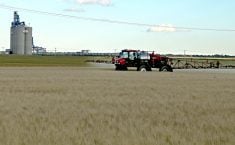The Bank of Canada touched off unease in some farming circles when it increased interest rates by a quarter of a percentage point last week.
The unease is caused by three main factors:
- The rate increase supports the rising value of the Canadian dollar, which reduces prices farmers receive for exported products.
- The increase raised the cost of servicing Canada’s record farm debt.
- During its announcement, the bank also hinted more increases might follow if the Canadian economy continues at a hot pace.”Farm debt in Canada is disproportionate to the debt in the United States and so any increase in debt servicing costs here hits at our competitiveness with the Americans,” Canadian Federation of Agriculture vice-president Ron Bonnett said July 13. “And of course this is a double hammer because it supports a strong dollar, which reduces the value of our export crops.”
Read Also

New coal mine proposal met with old concerns
A smaller version of the previously rejected Grassy Mountain coal mine project in Crowsnest Pass is back on the table, and the Livingstone Landowners Group continues to voice concerns about the environmental risks.
On July 13, the Canadian dollar closed at a 30-year record high of 95.65 cents US.
From Regina, Farm Credit Canada vice-president Michael Hoffort said a quarter percentage point rate hike increase will have little impact on farm debt servicing charges.
But it will increase the interest rate FCC has to pay when it borrows money to re-lend, forcing an increase in interest charges, and across a $14 billion portfolio, any increase adds tens of millions of dollars to debt service charges even if much of that debt is locked in at fixed rates.
“I think anticipation of higher rates has led many farmers to consider their debt structure and perhaps to lock in,” he said July 13. “The immediate impact of this will be minimal but it does send a signal and if it becomes a trend, we will be concerned.”
More hikes possible
On July 10, citing economic growth and higher-than-expected inflation, the Bank of Canada announced an increase in the trend-setting bank rate to 4.75 percent. Inflation is above the two percent target.
“Some modest further increase in the overnight rate may be required to bring inflation back to the target over the medium term,” bank governor David Dodge told a July 12 news conference.
He acknowledged that higher interest rates and a higher Canadian dollar have some potential down sides as it cools the economy and reduces inflation. “In the context of our new projection, the upside and downside risks appear to be roughly balanced,” Dodge said.
When he was asked about the farmer view that higher interest rates and a strong dollar are largely a negative for agriculture, the Bank of Canada governor suggested agriculture is doing well because of higher grains and oilseed prices and higher pork futures in Asia.
His message was that with stronger prices, in some cases caused by a strong global economy that is helping fuel interest rate increases, farmers are positioned to accommodate the higher debt servicing costs.
Bonnett, CFA vice-president and former Ontario Federation of Agriculture president, said Dodge was missing several points.
As commodity prices rise, so do input costs. “This does not necessarily translate into a stronger bottom line for farmers.”
And higher debt servicing charges with “thin margins” in Canada contrast with better farm income numbers and far lower per capita debt in the United States.
“Canadian farmers are incredibly vulnerable in all of this,” he said. “The prospect of more increases in interest rates is very worrying.”
















